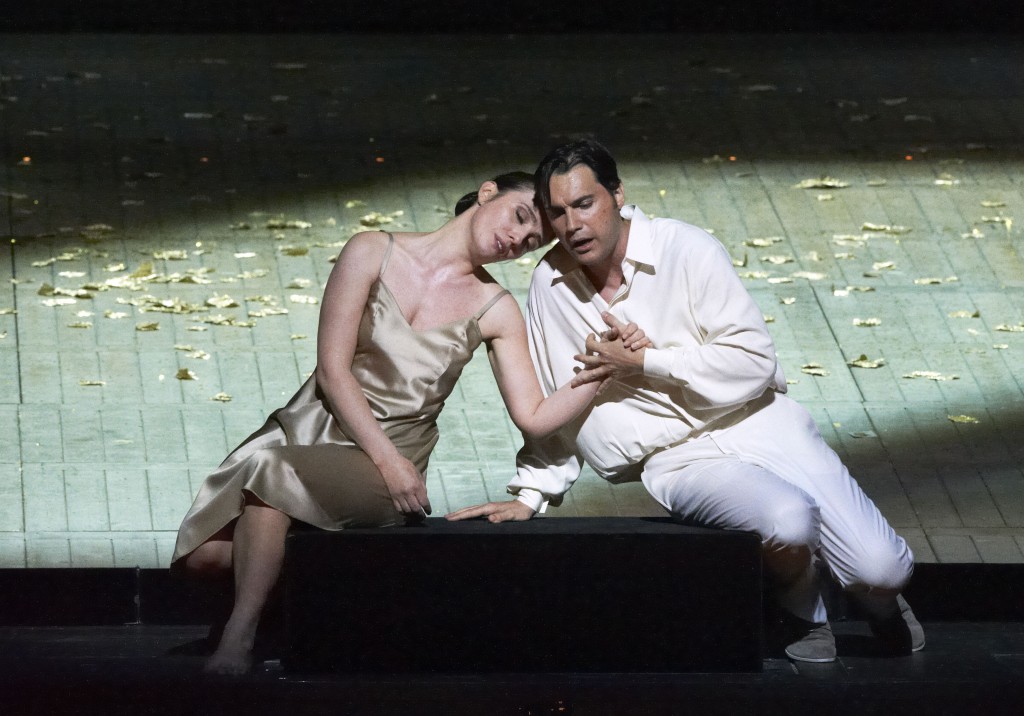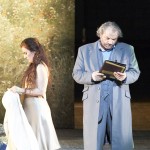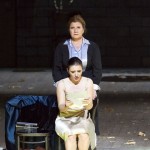 Opera needs to appeal to new and younger audiences. It is the job of director and stage designer to help us better understand a complex plot, and its characters. ‘Modern’ costumes and sets can make an opera more accessible . An opera need not be time and place specific.
Opera needs to appeal to new and younger audiences. It is the job of director and stage designer to help us better understand a complex plot, and its characters. ‘Modern’ costumes and sets can make an opera more accessible . An opera need not be time and place specific.
We should not have to know that Verdi’s La Traviata (Vienna State Opera) is based on ‘The Lady of the Camellias’, Alexander Dumas’ son’s semi-autobiographical novel, (and the death of the courtesan Marie Duplessis at only 23). Or that, Verdi, against the opposition of his stepfather, defended his marriage to a ‘singer’: to his right to a life heedless of social convention.
We do need to know that consumption was rife in the 19th century; also that fainting fits were common amongst ladies, and considered a sign of their ‘weaker’ nature. And that sickness was a metaphor for moral malaise. The protagonists of Camelias and Traviata were ‘courtesans’, considered women of easy virtue.
In Vienna State Opera’s new production (Director Jean -Francois Sivadier), we lose all context of Verdi’s opera. Sivadier sets the opera as if auditioning and rehearsing for ‘La Traviata’. Violetta comes on in blue satin skirt , halter top, applauded by contestants in chairs either side of a run-down hall. (This is where, at one of her splendid parties , much sought-after Violetta meets Alfredo Germont.) Here she’s thrown a bunch of flowers by Alfredo) after her set.
But, on this barely furnished stage as rehearsal room, we’re supposed to imagine Verdi’s chorus’s rousing Libiamo, ‘Let’s drink from the cup of pleasure’, singing as if they’re off to enjoy ‘wine and song through the night’. But where? Violetta collapses front of stage , dismissing her fainting as merely ‘a chill’.
So far Ermonela Jaho has charmed us as a convincing Violetta. But Francesco Demuro’s Alfredo is only routine , even when singing (Un di felice, eterea), of a love the heart beat of the universe . The chorus, however, are superb, thanking ‘the entertainers’: dawn is breaking, the city is full of parties.
In spite of the improbable set, Act 1 ends on a high note with Violetta’s arias. Jaho is very impressive revealing her true feelings, picking up Alfredo’s heartbeat refrain: her longing (Ah, fors e lui) for ‘love, mysterious, torment and rapture’, (how as a child she’d dreamt of the ideal man). Now, in a tight creamy silk skirt, she sings- with fantastic coloratura- of enjoying herself revelling in the whirlpool of desire: (Sempre libera degg’io) free to seek out new delights. The party girl, she’s back on stage with another dancing partner.
Act II, Scene 1 between Violetta and Georgio Germont is the most successful. (Retired to the country, Violetta’s given up her ‘life of luxury’; but she and Afredo are broke.) Alfredo’s father appears at Violetta’s appartment to persuade her to break with his son .The bourgeois ‘apartment’ we have to imagine is backed by two suspended ‘impressionist’ meadow scenes- another of blue sky with (symbolic) clouds. Zelijko Lucic is outstanding as Georgio, if anything too sympathetic, on a brutal mission he will later recant. He accuses Violetta of leading his son to ruin, although Violetta proves she’s had to sell off her own possessions. Violetta nevertheless vows to love Alfredo forever. Jaho is heart-breaking, powerful and unaffected, plaintively singing (Ah! dite alla giovene si bella e pura) he can tell his daughter, ‘a wretched woman is making this sacrifice before she dies’.
 And there’s ambiguity to their meeting: even a sexual frisson. Georgio, complimenting Violetta’s generosity, asks what he can do for her -as if to pay her off.
And there’s ambiguity to their meeting: even a sexual frisson. Georgio, complimenting Violetta’s generosity, asks what he can do for her -as if to pay her off.
Violetta sings Alfredo must know ‘I’m his until my last breath’, as she’s writing to Alfredo that she no longer loves him. Alfredo appears behind her as she sings her aria, ‘I’ll be there amongst the flowers’. Giorgio movingly relates his letter to his son to come home, an aria which won for Lucic deservedly loud cheers.
The pivotal Ball (scene 2), however, doesn’t quite work. Violetta is supposed to be out to a Ball with the Baron. But the cast (as Chorus) are acting out a scene for a play – with director side stage. It’s still a rehearsal, but we have to imagine matadors from Madrid come to enjoy themselves.
Really, it has to be a Ball , otherwise , where is the sense of social scandal (if this is all an act?) Imagining she’d left him for the Count, and her old life. Violetta is publicly humiliated by Alfredo, who’s been playing cards, and throws his winnings at her feet. Violetta collapses side of stage. The chorus again magnificent, affirm ‘we suffer for your pain’.
Sivadier’s production is least successful in the climactic Act 3. Violetta is left of stage, slumped like a fallen ballerina. The curtain rises to a near empty stage. Is this minimalism too far? Pendants in gold, as token chandeliers; rolled-up sheets , or bed linnen scattered randomly . Suffering alone, with Anina, Violetta reads George’s letter, sings (Addio del passato ) farewell to her dreams. She covers herself with a sheet. Her hair cropped , she looks emaciated For the final scene the ‘chandeliers’ have gone . Violetta’s standing side of stage , But there’s no sick bed? Alfredo returns, imploring forgiveness; in duet (Parigi, o cara!) forgetting Violetta’s hopeless condition. Georgio, a foolish old man , admits the harm he’s done. The ensemble, with father, son Anina, and doctor lamenting, whilst Alfredo begs Violetta not to die, is very good. Violetta is, ultimately, lying on stage, bare boards, with the bundled bed linen , and token blue jacket.
Yet, in spite of Jaho’s affecting performance , it isn’t as moving as it should be. She is standing front of stage when she rallies, falls back and dies. Without the sick bed the audience cannot suspend disbelief, to enable catharsis. For the full dramatic impact, even the greatest singers (Netrebko premiered in this production) need basic props for this scene.
As my neighbour, a Viennese lady and regular operagoer here put it, audiences come to expect the ‘cliches’. But each new director has to be different.
In spite of a strong performance from Jaho (who will grow into the role), and Lucic who provided the ballast, this new production did not move as I’d hoped. This was no fault of Vienna State Opera Orchestra under Bertrand de Billy, who researched and used Verdi’s original score, (cutting away 150 years of over-scoring); nor of Vienna State Opera Chorus, who always excel in Verdi. 20.05.2012 .

Photos: Ermonela Jaho (Violetta), Francesco Demura (Alfredo); Ermonela Jaho and Zeljko Lucic (Giorgio Germont); Ermonela Jaho (Violettta), Donna Ellen (Anina)
(c) Wiener Staatsoper/ Micheal Pohn

What’s up, I read your blog on a regular basis.
Your story-telling style is witty, keep it up!
Hello would you mind sharing which blog platform you’re using?
I’m planning to start my own blog in the near future but I’m having a tough time making a decision between BlogEngine/Wordpress/B2evolution and Drupal.
The reason I ask is because your design seems different
then most blogs and I’m looking for something unique.
P.S Apologies for getting off-topic but I had to ask!
Hello reader. I have been using the free version of WordPress, for which I am truly grateful. Good luck!
Hello, Neat post. There is an issue with your web site in internet explorer, may check
this? IE nonetheless is the marketplace chief and a good portion of other folks
will leave out your excellent writing because of this problem.
Great goods from you, man.
I actually like what you’ve acquired here, really like what you’re stating and the way in which you say
it. You make it enjoyable and you still take care to keep it wise. I can not wait to read far more from you.
This is actually a wonderful website.